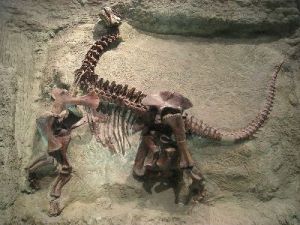
The results suggest that they spent time in the fluvial and wetland environments of the Morrison basin, as well as areas of high elevation. Reconstructions of the geology of the region implies that the dinosaurs must have migrated approximately 300 km in each direction to reach these areas.
‘Assuming that
Camarasaurus migrated in an effort to obtain the food and water they needed to survive’, say the authors, ‘they would have left the basin during the dry season (presumably summer) when plant growth was limited and drought might have been common, and then returned in the wet season (presumably winter).’
The teeth all showed similar patterns, suggesting the migrations took place in ‘herds’. Whilst the results show the dinosaurs moving from a basin environment to a highland one, they do not record a return to the basin, which must have occurred as the teeth were found there. This can be explained, say the researchers, by the fact that there is a ‘lag’ of approximately two weeks between the intake of oxygen and its expression in the body. The dinosaurs, then, are likely to have recently returned to the basin, and died during the transition from the dry to wet season.
The next step for the researchers is to carry out further studies of other
Camarasaurus populations, and of other sauropods in different areas, to establish whether the behaviour was a universal characteristic, or the result of particular environmental stresses. With further research, it is hoped that the role of migration in the evolution of sauropod gigantism might be better understood.
- Henry C. Fricke, Justin Hencecroth & Marie. E. Hoerner, 'Lowland-upland migration of sauropod dinosaurs during the Late Jurassic epoch, Nature Vol. 480 pp. 513 - 515